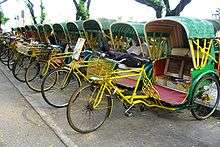車
| ||||||||
| ||||||||
Translingual
| Stroke order | |||
|---|---|---|---|
 | |||
Han character
車 (radical 159, 車+0, 7 strokes, cangjie input 十田十 (JWJ), four-corner 50006, composition ⿻亘丨 or ⿻二申)
- Kangxi radical #159, ⾞.
Derived characters
- Index:Chinese radical/車
- 庫
References
- KangXi: page 1239, character 1
- Dai Kanwa Jiten: character 38172
- Dae Jaweon: page 1712, character 34
- Hanyu Da Zidian: volume 5, page 3511, character 1
- Unihan data for U+8ECA
Chinese
| trad. | 車 | |
|---|---|---|
| simp. | 车 | |
Glyph origin
| Historical forms of the character 車 | |||||||||
|---|---|---|---|---|---|---|---|---|---|
| Shang | Western Zhou | Spring and Autumn | Warring States | Shuowen Jiezi (compiled in Han) | Liushutong (compiled in Ming) | ||||
| Bronze inscriptions | Oracle bone script | Bronze inscriptions | Bronze inscriptions | Bronze inscriptions | Chu Slip and silk script | Qin slip script | Shizhoupian script | Small seal script | Transcribed ancient scripts |
 |
 |
 |
 |
 |
 |
 |
 |
 |
 |
| Characters in the same phonetic series (車) (Zhengzhang, 2003) | |
|---|---|
| Old Chinese | |
| 車 | *kʰlja, *kla |
| 硨 | *kʰlja |
| 厙 | *qʰljaːs |
| 庫 | *kʰaːs |
Ideogram (指事) : it is derived from a pictogram of a carriage seen from above, with the long vertical stroke representing the axle, the central square representing the body of the carriage, and the top and bottom horizontal lines representing the wheels.
Note that 倝 (OC *kaːns) (as in left part of 朝 (OC *ʔr'ew, *r'ew)) is not derived from 車.
Pronunciation 1
Definitions
車
- † chariot; cart
- land wheeled vehicle; (specifically) car (Classifier: 輛/辆; 部; 臺/台; 架 c; 頂/顶 mn)
- machine; instrument (Classifier: 部)
- † carry in cart
- † to machine, to shape with a lathe
- to tailor or sew using a sewing machine
- (Cantonese) to drive somebody; to give somebody a ride
- (Sichuan) to rotate
- (Internet slang) pornography
- A surname.
Usage notes
Compounds
|
|
|
Pronunciation 2
Compounds
Japanese
Readings
Affix
Etymology 2
| Kanji in this term |
|---|
| 車 |
| くるま Grade: 1 |
| kun’yomi |
From Old Japanese. Appears in the Man'yōshū completed some time after 759 CE, with the ideographic spelling 車.[1]
Assuming an initial meaning of wheel, may be a compound of くる (kuru, related to spinning or rotating, as in 繰る (kuru, “to spin (as in thread)”), 枢 (kuru, “hinge”), くるくる (kurukuru, “spinningly, round and round”), 転めく (kurumeku, “to spin round and round, to rotate; to be dizzy”)) + ま (ma, a suffix added to various parts of speech to form an indeclinable word indicating state).
Noun
車 (counter 台, hiragana くるま, rōmaji kuruma)
- a car, an automobile, a carriage, a cart
- a wheel, a caster
- something wheel-shaped
- a style of 紋 (mon, “family crest”)
- short for various terms:
- short for 車海老 (kuruma ebi): a prawn
- short for 車懸 (kuruma-gakari): “wheel formation”, a battle tactic where units attack in staged waves in order to prevent the opponent from resting
- short for 肩車 (kata-guruma): riding on one's shoulders, piggyback
- short for 手車 (te-guruma): a handcart, a wheelbarrow
- short for 車座 (kuruma za): sitting in a circle
- (obsolete) during the Edo period, in the red-light district in Ōsaka, a prostitute whose services cost four 匁 (monme) and three 分 (bun) (possibly in reference to the cost of a carriage ride)
Derived terms
- 車椅子 (kurumaisu, “wheelchair”)
Korean
Etymology 1
Compounds
Etymology 2
Kunigami
Pronunciation
- IPA(key): /kˀuɾumaː/
Miyako
Pronunciation
- IPA(key): /kuɾuma/
Okinawan
Pronunciation
- IPA(key): /kuɾuma/
Vietnamese
Han character
- This term needs a translation to English. Please help out and add a translation, then remove the text
{{rfdef}}.
Yaeyama
Pronunciation
- IPA(key): /kuɾuma/
Yonaguni
Pronunciation
- IPA(key): /kuɾuma/

